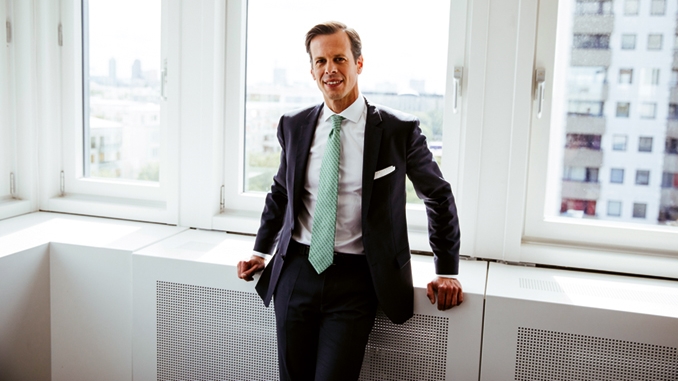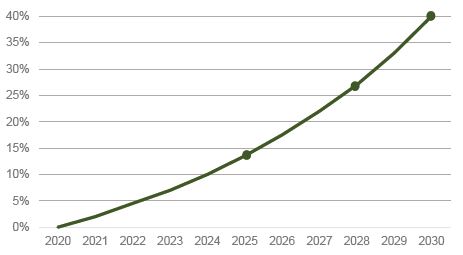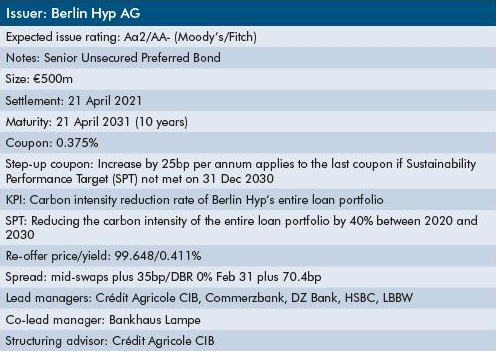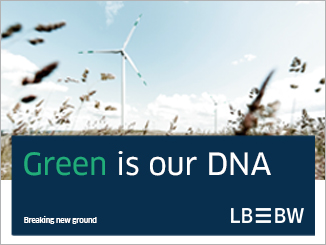
Berlin Hyp became the first bank to issue a sustainability-linked bond (SLB) on Tuesday, 13 April, with a €500m 10 year senior preferred deal. Bodo Winkler-Viti, Berlin Hyp’s head of funding and investor relations, discussed with Sustainabonds’ Neil Day the pioneering first issue, the rationale for adopting the new instrument and the bank’s choice of metrics, and how SLBs fit in with its green bond issuance.
You can download a pdf version of this article here.
Neil Day, Sustainabonds: Why has Berlin Hyp decided to issue sustainability-linked bonds?
Bodo Winkler-Viti, Berlin Hyp: The foundation of this whole sustainability-linked bond project is our sustainability agenda, which we published in August last year. This agenda goes far beyond what we previously had as a strategic target. That earlier target for green buildings to constitute 20% of our financings by the end of 2020 — which we achieved early and have increased — clearly referred to a sub-portfolio of the bank. The sustainability agenda relates to the entire bank.
The most important goal of this agenda is reaching climate neutrality — not only for ourselves, but also for our whole portfolio — by the end of 2050, in line with the climate path set by the Federal Republic of Germany. In our case, this requires a 40% reduction in the carbon intensity of our portfolio between 2020 and 2030. To meet the Paris Agreement goals, this is how much we have to reduce carbon emissions by in the building sector.
Our sustainability agenda has other goals, which are all interconnected: we aim to further increase our green finance portfolio to one-third of the overall portfolio; we aim to achieve complete portfolio transparency by the end of 2023, meaning recording energy demands and uses for all the buildings that we finance; and we have a new product that is to be launched in the near future, the transformation loan, which will incentivise and support the green renovation of properties. These three lesser goals all support the overarching goal of contributing positively to the climate agreement goal.
Looking at these four building blocks of our agenda, it is clear that important steps that one would need to take towards issuing an SLB have already been taken by us. There is a quantifiable goal — a very strong and relevant one — and also the ability to measure our progress because of the impact methodology designed for our green bonds, which we have further developed to be able to assess the whole portfolio. The database will get better and even more precise until the end of 2023, by which time we aim to have all the real data there so we no longer have to work with proxies for part of the portfolio.
So a lot of the elements for an SLB were already on the table, allowing us to say, OK, we can use this new product to make others aware of what we are doing, and to set a good example and perhaps encourage others to follow. It demonstrates very clearly to both the capital markets but also the real estate sector that something needs to be done in these sectors, with the capital markets supporting the real estate sector in contributing towards achieving the Paris Agreement goals.
And we naturally want to further broaden our investor base. Berlin Hyp is 100% refinanced via capital markets, so a broad investor base is in itself an important target, and this new product can contribute to that.
Day, Sustainabonds: A relevant KPI and ambitious sustainability performance target (SPT) are critical elements of an SLB. Can you expand on your choices, and why perhaps you didn’t focus on the green building portfolio.
Winkler-Viti, Berlin Hyp: First of all, a relevant target has to be ambitious. If it’s not, it’s not relevant. And it has to somehow fit the issues that you are dealing with in your business. One of the big issues in real estate is that the sector is one of the biggest emitters of CO2 — in Germany, in Europe, worldwide. And of course if you then want to reach a well below 2 degrees scenario, you need to address sectors that are very relevant to overall emissions.
Why not use the one-third green target? There is still no proper definition on the table of what is and what is not a green building. Very soon there will be a taxonomy that will give more clarity around this, but it’s not available at the moment. And then the EU Taxonomy not only covers the greenness of a building, but also various do-no-significant-harm criteria that address other ESG aspects, and if you don’t meet them, the whole asset is not taxonomy-aligned, which then makes it more difficult to separate out only the green factor. So the taxonomy has difficulties that would make the target a little less clear than the one we have chosen.
Our KPI — the carbon intensity reduction rate of our portfolio — is based on a widely accepted metric, expressed in kilogrammes of CO2 per square metre. This is measured every year and in 2030 it has to be 40% lower. This is derived directly from the Paris Agreement, so it is by definition a relevant and ambitious target, because the whole Paris Agreement is relevant and ambitious.
Berlin Hyp’s carbon intensity reduction trajectory

Source: Berlin Hyp
Berlin Hyp’s profile, in both the real estate market and the capital markets, is as a green bank, so it is not surprising that our SLB refers to a green topic. In the end, it all goes back to our sustainability agenda, which very clearly focuses on the E aspect out of ESG. Putting more emphasis on the social part will be a task for the future for us, too. But where we have expertise and can deliver something at this time is the environmental aspect, and therefore it was only logical for us to do this. We also wanted to have a structure that is easily understandable, and having only one KPI makes it easier for investors to discern whether or not we are on track, rather than if we had five and one developed in one direction and another in the opposite direction.
We hope the market will appreciate our KPI and sees that it is clear and fits the bank very well, because that is important: it should come out of the bank’s strategy, and not just be invented in order to produce a bond.
Day, Sustainabonds: Beyond the items on your sustainability agenda, what can you tell us about how the target will be achieved? I understand it depends on regulatory and political developments as well as your own activities.
Winkler-Viti, Berlin Hyp: Firstly, our own management skills are involved. We have already included a sort of traffic lights system into our credit processes, which means that whoever makes the decision whether or not we enter into a loan can see at a glance whether the specific asset that we are going to finance contributes positively, neutrally or negatively to our target. So if the energy efficiency of a newly-to-be-financed building is worse than the average of our existing portfolio, the traffic light is on red. You can overrule that for other economic reasons, of course, but it is at least shown. The same applies to our portfolio management system, so, for instance, when we decide to syndicate properties, the portfolio managers also know whether this contributes in a positive or in a negative way to our target. So we are in the driving seat there.
Last, but not least, our soon-to-be-launched transformation loan will help us to achieve our target. It will be used to finance renovations of energy-inefficient buildings targeting a primary energy demand reduction of at least 30%.
Where we are also in the driving seat is that we continue to incentivise loans for green buildings, and every new green building that we finance contributes positively to reaching our target. So that is what we can do ourselves.
Where we depend on others is all the regulatory aspects and the policies that are planned. There is a clear plan how to decarbonise the energy sector here in Germany and in other European countries, for instance, but this really needs to be translated into action. If there are delays, this will negatively impact us in reaching our goals. The same is true of the construction sector. One of the questions there is whether the new EU Taxonomy criteria will be sufficiently interesting for new buildings that they are adopted, or if developers will decide that they are too burdensome and their buildings end up not Taxonomy-compliant.
In that eventuality, we would have the option of increasing our own measures to compensate for shortcomings that arise elsewhere. But those are clearly risks to us achieving our target.
Day, Sustainabonds: It’s only a year and a half since the first SLB, although we have seen significant growth since the Sustainability-Linked Bond Principles (SLBP) were published last summer. Was there a template that you could easily work with, or were there challenges in producing your framework — also since you are the first bank to issue an SLB?
Winkler-Viti, Berlin Hyp: The SLBP are a big help, as the Green Bond Principles (GBP) are for first time green bond issuers. The SLBP form very clear guidelines that are very useful in applying to your own framework, and they really guided us through the process.
When it comes to defining the KPI and the SPT, there was no blueprint in the market, because no other bank has issued, and so far there has not been an SLB exclusively linked to the real estate sector. So ultimately it is all our own work — and it was a lot of work. We started working on it when our sustainability agenda was not yet published, last summer, and we have only now finalised it some eight months later, so quite a long time.
One project was related to the KPI: although we already knew how to measure it, we wanted to make it watertight. When we did the impact reporting for our green bond portfolio, there were about 250 assets, and we took the values from our loan monitoring system but basically did the calculations on Excel spreadsheets. For the whole portfolio of more than 5000 assets and with new conversion factors ever year, this method is no longer appropriate; it needs to be done in the monitoring system itself, so it is all now done out of our SAP system, and we have a nice product that is more manageable for us.

Illustration: Berlin Hyp
Day, Sustainabonds: Some investors who may have been very interested in your green bonds and the use of proceeds concept might be a bit more sceptical about SLBs as a general concept, while also pointing at features like the coupon step-up. What’s your take on this? Also, what are the chances of you using a coupon step-down, as allowed for in your framework?
Winkler-Viti, Berlin Hyp: First of all, investors are not getting rewarded if Berlin Hyp misses its target; they are compensated. For me that is a big difference. What is the thinking behind this compensation? As we have already outlined, the targets that you choose should be extremely relevant for you and your industry. And if you miss them, this might affect your credibility and solvency. So what we tell investors with our SLB is, OK, if we don’t reach this target, this might negatively affect the credit quality of Berlin Hyp, and we are already offering you now, 10 years in advance, potential compensation for that eventuality. Because if we don’t reach this target, maybe you don’t have a double-A rated asset in your portfolio anymore, maybe it’s only single-A, and then our funding costs would be higher, so you get the compensation straight away. It is always important to point that out. I don’t want to incentivise anybody to hope that we don’t reach our target, and we are clearly not doing this.
Regarding the straightforward structure that we chose — with just a single step-up coupon, right at the end of the bond — why did we adopt that? We have a unique situation: we are issuing a 10 year bond and we have a 10 year target, and they share the same time period — nothing would make more sense than using precisely this structure. The target itself is very ambitious and the KPI strong, so why should we use any of the suggested interim target observation periods if we can have the full period reflecting the full target?
You are right, we also have embedded in our framework the option of applying a step-down in future. It is not included in this inaugural issue because, as I mentioned, we want to keep things simple at this point, and the market has not yet seen any SLBs with a step-down. I nevertheless see some potential for this, because if you do much better than targeted, this should have positive credit effects as the KPI is very relevant for you, and so you as the issuer should be compensated — this is, of course, the flipside of the rationale for the step-up. So this could be something interesting for the future. But although we like pioneering with new instruments, we don’t want to stress out the market by bringing a new instrument that also includes a new feature.
Day, Sustainabonds: Your framework allows you to issue SLBs as both senior unsecured and covered bonds. Why have you chosen the senior preferred format for your first issue?
Winkler-Viti, Berlin Hyp: As the use of proceeds is very general and hence linked to the overall strategy of the bank, we feel better about using an instrument that is more linked to the whole balance sheet and not just a part, which the cover pool would represent, and therefore this applies better to senior or even capital products. However, we are still developing our thinking in this respect.
Day, Sustainabonds: How has your inaugural SLB been received?
Winkler-Viti, Berlin Hyp: We are super-happy with the result. We understand the final spread of 35bp makes it the tightest 10 year senior preferred bond since Nordea in 2017 and it is our tightest 10 year senior preferred issue yet. We saw fair value in the low to mid 30s, so there was only a basis point or so of new issue premium, which is minimal. I would say the ESG linkage helped us achieve this.
Peaking at close to €1bn, the book is not the biggest we have ever achieved, but a significant number of the investors that we met for one on one meetings in our virtual roadshow are dedicated to ESG, with their analysts asking a lot of questions, and we ultimately encountered them in the order book, which is something of an endorsement of the project.
We have issued the first SLB from a bank and the amazing outcome shows that the market is open for innovative structures. This transaction took longer to prepare than any other from Berlin Hyp and it’s a great feeling to have finally completed it so successfully. We have been able to issue a beautiful tightly-priced SLB and are absolutely grateful for the result. The market clearly honours ESG targets and our approach to sustainability.
Day, Sustainabonds: Aside from any conceptual issues people might have with the coupon step-up feature, was it a problem for any investors from a practical perspective?
Winkler-Viti, Berlin Hyp: We received feedback from several smaller, mostly domestic investors who said they are very interested in it, but they would have needed to go through a process for a new product and so apparently everybody was not able to participate at this point. But hopefully this is not our last SLB and we can reach them when we return.
Day, Sustainabonds: There has been some scepticism about how much bank SLB supply might follow — what do you make of that?
Winkler-Viti, Berlin Hyp: There is indeed an ongoing discussion about whether bonds that are usually bail-in-able would be MREL-eligible if they contain a structural element or option that could be seen by the supervisory authorities as potentially incentivising the issuer to redeem the bond.
However, I don’t see such a problem with the step-up coupon of an SLB: there is no such option enabling us to pay back the bond early for economic reasons; the coupon will simply step up at a certain point if we have failed to reach the SPT.
Anyhow, this issue does not concern us, since our senior preferred bonds are non-MREL eligible — our MREL ratio stands at 57%, so we are very comfortable in this regard.
Day, Sustainabonds: What does your adoption of SLBs mean for your green bond issuance?
Winkler-Viti, Berlin Hyp: This is a different instrument and a complementary one. It will not replace green bonds. New green assets at Berlin Hyp are refinanced by green bonds and they will be refinanced by green bonds in the future, too. But the green bonds that we have increasingly issued will, of course, not be able to fill our entire funding needs. To achieve our aim of green building financings constituting one-third of the overall portfolio, about 50% of new loans every year have to be loans for green buildings — but the other 50% still needs to be refinanced. This can be done by plain vanilla conventional bonds, senior unsecured and Pfandbriefe, but a part of that can be done by SLBs.
So it’s a new, additional instrument. It is a logical next step after green bonds, because with their strong use of proceeds approach, we always referred to a very specific portfolio. With SLBs, the proceeds will be used for general corporate purposes and it is more an instrument to tell the market: this is our ESG target, this is how we want to reach it, we will report annually how we have progressed, and you can measure us against this. So the two instruments are quite independent of each other, and Berlin Hyp will continue, of course, to issue green bonds.
Day, Sustainabonds: How do you see the wider SLB market itself developing, and also within the context of wider sustainable bond developments?
Winkler-Viti, Berlin Hyp: The overall ESG debt capital markets have already developed very well in recent years. Back in 2015 we were the first to issue a covered bond in green format worldwide and even the first European bank to come with a benchmark-sized green bond, and at that time I was already quite sure others would follow and that the market would be unstoppable. If you look now at how issuance volumes have risen exponentially in the past few years, it is indeed unstoppable.
Now, SLBs are the new kid on the block, playing a slightly different role than the three existing instruments, because they are the first without the use of proceeds approach. I believe they can play a very big role, also for issuers who want to finance their transition rather than something that is already green — it is very useful for that. That’s one reason why this market has so far been dominated by corporates — if you look more closely at the names involved — from the construction/building sector with lots of CO2 emissions, for example, or pharmaceuticals with other ESG issues — some of them have a long way to go to be regarded as more sustainable.
Sustainabonds conducts all research and writing independently to maintain the full editorial integrity of the publication.
As a supporter of Sustainabonds, LBBW is facilitating a series of interviews with leading players in ESG and the green, social and sustainability bond markets.





